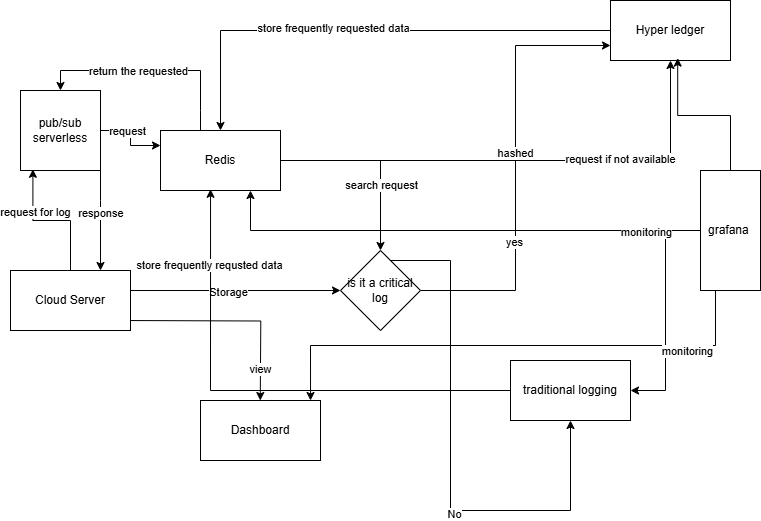Can Blockchain and Cloud Work Together for Real-Time Logging?
The number of likes gonna decide my project idea, on an interesting note about the cloud logging system, I and my teammate proposed a real-time logging using Hyperledger
The idea was simple: How can we make cloud logging real-time and secure without compromising performance or cost?
So we asked ourselves, "What if we could combine the speed of real-time processing with the security of blockchain?"
Architecture & Workflow:
Working:
Log Generation: Cloud server generates logs → Sent to Pub/Sub for processing.
Log Routing: Pub/Sub sends logs to Redis for caching and fast access.
Pub/Sub also sends logs for classification (critical vs non-critical).Critical Log Handling: If it’s a critical log → Log is hashed and sent to Hyperledger for tamper-proof storage. Redis stores the log for quick future access.
Non-Critical Log Handling: If it’s a non-critical log → Sent to traditional logging for storage. Redis stores frequently accessed logs.
Retrieval: If a log is requested → Redis provides a fast response if the log is available. If Redis misses → Hyperledger provides the log → Redis updates its cache.
Monitoring:
Grafana monitors: Redis (real-time performance), Hyperledger (security and consistency), Traditional logging (success/failure feedback)-
Failure Handling:
- If Redis fails → Pub/Sub retries the request or falls back to Hyperledger.
- If Hyperledger write fails → Log is stored in Redis as "pending" and retried later.
- If traditional logging fails → Grafana generates an alert.
Advantages:
1. Speed and Real-Time Performance:
Redis + Pub/Sub = High-speed log processing (low latency).
Logs are available instantly for search and monitoring.
2. Security and Data Integrity:
Hyperledger ensures logs are tamper-proof and cryptographically secured.
Blockchain-based hashing guarantees that logs cannot be altered post-storage.
3. Fault Tolerance and High Availability:
Pub/Sub allows retry and message buffering → Prevents data loss.
Redis replication and Hyperledger peer-based consensus ensure high availability.
4. Scalability:
Redis + Pub/Sub = Horizontal scaling for high-volume log handling.
Hyperledger can scale for increased load by adding more peers.
Decoupling of Processing and Storage:
Redis (for speed) and Hyperledger (for integrity) work independently → No bottlenecks.
5. Unified Monitoring:
Grafana provides centralized monitoring across all components (Redis, Hyperledger, traditional logs).
Alerts and health checks ensure system health and proactive failure handling.
6. Compliance and Regulatory Value:
Financial and healthcare industries require immutable logs for audits → Blockchain provides proof of integrity.
Perfect for industries needing regulatory-compliant logging.
Commercial Value:
1. Target Market:
Cloud-native applications (SaaS, web apps, microservices).
Kubernetes deployments needing scalable log pipelines.
DevOps teams seeking real-time insights + security.
2. Competitive Edge:
Datadog and Splunk provide real-time logging but lack blockchain-based integrity. Your solution offers both speed and verifiability → Strong selling point. Multi-cloud support (via Kubernetes) = Portable across AWS, GCP, Azure → Reduces vendor lock-in.
Drawbacks:
1. High Complexity:
More components (Redis + Pub/Sub + Hyperledger) = More maintenance and complexity.
Datadog and Splunk are easier to set up — Your system requires skilled DevOps knowledge.
2. Blockchain Latency:
Hyperledger consensus adds latency (~100ms–500ms) → Could affect real-time responsiveness.
Solution → Cache critical logs in Redis before blockchain commit.
3. Cost of Hyperledger Storage:
Storing full logs in Hyperledger could get expensive at scale.
Solution → Store only log hashes in Hyperledger and full logs in Redis or traditional storage.
4. Limited Hyperledger Scalability:
Hyperledger scales linearly → Adding more peers increases consensus time.
Solution → Use a batching model to reduce the number of consensus events.
5. Pub/Sub Complexity:
Pub/Sub introduces message handling complexity (ordering, retries).
Solution → Use dead-letter queues (DLQ)
Poll & Feedbacks
- Do you think its an overkill project?
- Can you please explain to me if this a complex and does not solve any purpose?
- if its good points to improve ?



Top comments (1)
Love the concept! 🔥 Real-time logging + blockchain integrity is a solid combo—perfect for compliance-heavy apps. Not overkill at all, just needs smart scaling.